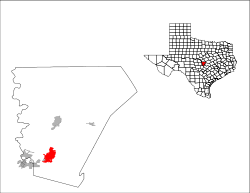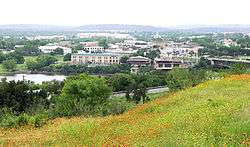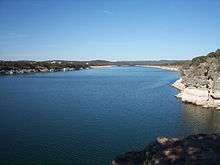Marble Falls, Texas
| Marble Falls, Texas | |
|---|---|
| City | |
|
Hill view of Marble Falls, 2007 | |
| Motto: "Marble Falls... for a weekend, or a lifetime" | |
|
Location of Marble Falls, Texas | |
 | |
| Coordinates: 30°34′N 98°17′W / 30.567°N 98.283°WCoordinates: 30°34′N 98°17′W / 30.567°N 98.283°W | |
| Country | United States |
| State | Texas |
| County | Burnet |
| Area | |
| • Total | 12.2 sq mi (31.6 km2) |
| • Land | 11.6 sq mi (30.0 km2) |
| • Water | 0.6 sq mi (1.6 km2) |
| Elevation | 823 ft (251 m) |
| Population (2010) | |
| • Total | 6,077 |
| • Density | 525/sq mi (202.8/km2) |
| Time zone | Central (CST) (UTC-6) |
| • Summer (DST) | CDT (UTC-5) |
| ZIP codes | 78654, 78657 |
| Area code(s) | 830 |
| FIPS code | 48-46584[1] |
| GNIS feature ID | 1362162[2] |
| Website |
ci |
Marble Falls is a city in Burnet County, Texas, United States. As of the 2010 census, the city population was 6,077.[3] It is about 48 miles (77 km) northwest of downtown Austin and 85 miles (137 km) north of San Antonio.
Lake Marble Falls is part of the Highland Lakes on the Colorado River, the largest chain of lakes in Texas.[4] It hosts one of the largest drag boat races in the United States each August.[5][6][7]
History
Marble Falls was founded in 1887 by Adam Rankin Johnson, a former Indian fighter and Confederate general, known as "Stovepipe" Johnson for his Civil War escapades, which included duping the Union army in Newburgh, Indiana, with fake "cannons," constructed from stovepipes and wagon wheels. Johnson had viewed the natural Marble Falls during his pre-war days as a Burnet County surveyor, and had dreamed of building an industrial city, powered by the tumbling Colorado River, not to be confused with the river of the same name in Colorado and Arizona. Despite a "friendly fire" incident which blinded him near the end of the Civil War, General Johnson followed through with his dream, facilitating the construction of a railroad to nearby Granite Mountain in 1884, then (with ten partners, including one son, one nephew and two sons-in-law) platting the townsite and selling lots, beginning July 12, 1887. Johnson built a fine home, a college (soon to be home of the "Falls on the Colorado Museum") and a large factory near the falls. The town grew to a population of 1,800 within ten years.
Marble Falls made history in 1917 by electing Ophelia Crosby "Birdie" Harwood as the nation's first woman mayor, three years before women were allowed to vote.
When the Max Starcke Dam was completed in 1951, the marble falls which had given the town its name were submerged under the new Lake Marble Falls. While the town's economy struggled through the drought of the 1950s, a new economy based on tourism and retirement began to grow in the 1970s. During the last thirty years, Marble Falls has grown into the retail and entertainment center for the Highland Lakes area, and continues to attract tourists, retirees and new businesses.[8]
Geography
Marble Falls is located in southern Burnet County at 30°34′N 98°17′W / 30.567°N 98.283°W (30.5741, -98.2782),[9] on the banks of Lake Marble Falls. According to the Handbook of Texas website, the former falls were flooded by the lake, which was created by a shelf of limestone running diagonally across the Colorado River from northeast to southwest. The upper layer of limestone, brownish on the exterior but a deep blue inside, was so hard and cherty it was mistaken for marble. The falls were actually three distinct formations at the head of a canyon 1.25 miles (2.01 km) long, with a drop of some 50 feet (15 m) through the limestone strata. The natural lake and waterfall were covered when the Colorado River was dammed with the completion of Max Starcke Dam in 1951. A photo of the falls as they once existed can be seen at the website for the Wallace Guest House, a local bed and breakfast.[10] Lake Marble Falls sits between Lake Lyndon B. Johnson to the north and Lake Travis to the south. The falls for which the city is named are now underwater but are revealed every few years when the lake is lowered.
Equally noteworthy is the huge igneous batholith called Granite Mountain looming on the town's western edge that secured Marble Falls' place in Texas history. The famed pink granite was used for the construction of the Texas State Capitol and other state government office buildings, and can also be found in the Galveston Seawall and Austin–Bergstrom International Airport.[11]
According to the United States Census Bureau, the city has a total area of 12.2 square miles (31.6 km2), of which 11.6 square miles (30.0 km2) is land and 0.62 square miles (1.6 km2), or 5.21%, is water.[3]
Demographics
| Historical population | |||
|---|---|---|---|
| Census | Pop. | %± | |
| 1890 | 587 | — | |
| 1910 | 1,061 | — | |
| 1920 | 630 | −40.6% | |
| 1930 | 865 | 37.3% | |
| 1940 | 1,021 | 18.0% | |
| 1950 | 2,044 | 100.2% | |
| 1960 | 2,161 | 5.7% | |
| 1970 | 2,209 | 2.2% | |
| 1980 | 3,252 | 47.2% | |
| 1990 | 4,007 | 23.2% | |
| 2000 | 4,959 | 23.8% | |
| 2010 | 6,077 | 22.5% | |
| Est. 2014 | 6,185 | [12] | 1.8% |
As of the census[1] of 2010, there were 6,077 people, 2,486 households, and 1,542 families residing in the city. There were 28,235 housing units. The racial makeup of the city was 83.1% White, 3.9% African American, 0.7% Native American, 0.8% Asian, 9.1% from other races, and 2.4% from two or more races. Hispanic or Latino of any race were 24.2% of the population.
There were 2,486 households out of which 29.8% had children under the age of 18 living with them, 42% were married couples living together, 14.6% had a female householder with no husband present, and 38% were non-families. The average household size was 2.41 and the average family size was 3.08.
Marble Falls, as of December 1, 2009, is the anchor of the Marble Falls, TX Micropolitan Statistical Area. The census bureau has defined this area as including all of Burnet County and has a total population of 42,896. The micropolitan area, due to close ties to nearby Austin, is a component of the Austin-Round Rock-Marble Falls, TX Consolidated Statistical Area.[14]
Notable people
- Gerald Lyda (1923–2005), general contractor and cattle rancher, born and raised in Marble Falls[15]
- Leonel Manzano, silver medal winner in the 1500m at the 2012 London Olympics, NCAA 1500m Champion, member of the USA 2008 Beijing Olympic Team and the USA 2012 London Olympic Team
- John Arthur Martinez, second-place winner on USA Network's Nashville Star, taught English and tennis at Marble Falls High School.
Gallery
-
Marble Falls City Hall, 2011
-
Marble Falls Public Library, 2011
-
The Uptown Theater in downtown Marble Falls, 2011
-
Texas Ranch to Market Road 1431 in Marble Falls extends westward, 2011
See also
- Marble Falls Independent School District
- Texas Tech University at Highland Lakes
- Central Texas College - Marble Falls
References
- 1 2 "American FactFinder". United States Census Bureau. Retrieved 2008-01-31.
- ↑ "US Board on Geographic Names". United States Geological Survey. 2007-10-25. Retrieved 2008-01-31.
- 1 2 "Geographic Identifiers: 2010 Demographic Profile Data (G001): Marble Falls city, Texas". U.S. Census Bureau, American Factfinder. Retrieved April 23, 2014.
- ↑ "Welcome to the City of Marble Falls". Ci.marble-falls.tx.us. 1907-05-18. Retrieved 2010-02-09.
- ↑ http://www.marblefallslakefest.com/event.html
- ↑ http://www.ci.marble-falls.tx.us/lakeside_park.html
- ↑ http://www.dragboats.com/schedules.php?Param=Year&Value=2012
- ↑ "Marble Falls community information and history". Marblefalls.info. Retrieved 2010-02-09.
- ↑ "US Gazetteer files: 2010, 2000, and 1990". United States Census Bureau. 2011-02-12. Retrieved 2011-04-23.
- ↑ Wallace Guest House
- ↑ History of Granite Mountain
- ↑ "Annual Estimates of the Resident Population for Incorporated Places: April 1, 2010 to July 1, 2014". Retrieved June 4, 2015.
- ↑ "Census of Population and Housing". Census.gov. Retrieved June 4, 2015.
- ↑ http://www.whitehouse.gov/omb/assets/bulletins/b10-02.pdf
- ↑ "La Escalera Ranch - The Legacy - Gerald Lyda". Escalera.us. Retrieved 2010-02-09.
External links
| Wikimedia Commons has media related to Marble Falls, Texas. |
- City of Marble Falls official website
- Marble Falls, Texas from the Handbook of Texas Online
- Marble Falls/Lake LBJ Chamber of Commerce
- The Highlander, Marble Falls newspaper
- Granite Mountain article
| |||||||||||||||||||||
| ||||||||||||||||||||||||||||||||||||||||||


